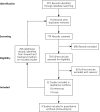Blue-Light Therapy for Acne Vulgaris: A Systematic Review and Meta-Analysis
- PMID: 31712293
- PMCID: PMC6846280
- DOI: 10.1370/afm.2445
Blue-Light Therapy for Acne Vulgaris: A Systematic Review and Meta-Analysis
Abstract
Purpose: Antibiotic use in acne treatment raises concerns about increased resistance, necessitating alternatives. We assessed the effectiveness of blue-light therapy for acne.
Methods: We analyzed randomized controlled trials comparing blue light with nonlight interventions. Studies included people of any age, sex, and acne severity, in any setting, and reported on investigator-assessed change in acne severity, patients' assessment of improvement, change in inflammatory or noninflammatory lesions, and adverse events. Where data were sufficient, mean differences were calculated.
Results: Eighteen references (14 trials) including 698 participants were included. Most of the trials were small and short (<12 weeks) and had high risk of bias. Investigator-assessed improvement was quantitatively reported in 5 trials, of which 3 reported significantly greater improvement in blue light than comparator, and 2 reported improvement. Patients' assessments of improvement were quantitatively reported by 2 trials, favoring blue light. Mean difference in the mean number of noninflammatory lesions was nonsignificant between groups at weeks 4, 8, and 10-12 and overall (mean difference [MD] = 3.47; 95% CI, -0.76 to 7.71; P = 0.11). Mean difference in the mean number of inflammatory lesions was likewise nonsignificant between groups at any of the time points and overall (MD = 0.16; 95% CI, -0.99 to 1.31; P = 0.78). Adverse events were generally mild and favored blue light or did not significantly differ between groups.
Conclusion: Methodological and reporting limitations of existing evidence limit conclusions about the effectiveness of blue light for acne. Clinicians and patients should therefore consider the balance between its benefits and adverse events, as well as costs.
Keywords: acne vulgaris; humans; light; phototherapy.
© 2019 Annals of Family Medicine, Inc.
Figures




References
-
- Zaenglein AL, Pathy AL, Schlosser BJ, et al. Guidelines of care for the management of acne vulgaris. J Am Acad Dermatol. 2016; 74(5): 945–973.e33. - PubMed
-
- Kwon HH, Lee JB, Yoon JY, et al. The clinical and histological effect of home-use, combination blue-red LED phototherapy for mild-to-moderate acne vulgaris in Korean patients: a double-blind, randomized controlled trial. Br J Dermatol. 2013; 168(5): 1088–1094. - PubMed
-
- Dessinioti C, Katsambas A. Propionibacterium acnes and antimicrobial resistance in acne. Clin Dermatol. 2017; 35(2): 163–167. - PubMed
Publication types
MeSH terms
LinkOut - more resources
Full Text Sources
Medical
